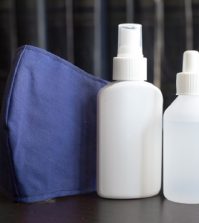- Study Says Most Parents Don’t Use Car Seats In Ride Share Vehicles Like Uber
- This 12-Year-Old Boy Is A Sophomore Aerospace Engineering Major!
- Fire Safety Experts Warn Of Hand Sanitizer Danger After A Mom and Kids Escape House Fire
- Recall Alert: Peaches May Be The Cause Of Salmonella Outbreak, 68 People Ill
- Summer Vacation In The Days Of COVID: Tips To Stay Safe
- How To Safely Grocery Shop During The Coronavirus Pandemic
- Michigan Teen With Vape-Related Illness Undergoes Double Lung Transplant
- Teen Kicks Off Anti-Vaping Campaign From Hospital Bed
- Teenager Receives Life Sentence For Strangling Sister To Death Over A Wi-Fi Password
- Toddler Falls To Death From 11th Deck of Cruise Ship
Alert: Sea Lice Reported Along Beaches


If you’re making your way to the beach, it may just leave you with an itchy rash – as a number of people are reporting cases of “sea lice” after a swim in Florida’s waters.
Those who have been affected experience an itchy, irritated rash — that often come with bumps and welts.
In more serious cases, people may experience flu-like symptoms like fever, headache, chills and nausea.
This week, lifeguards in Pensacola reported mild cases of “sea lice” and hoisted purple flags to warn beachgoers, according to a report from WEAR.
What is “sea lice” exactly and how can you avoid it?
Despite the name, ”sea lice,” is not actually lice.
It’s actually a rash that is caused by miniature larvae of marine life — like jellyfish or sea anemones.
The term actually refers to the condition that is caused by the larvae stings, more accurately known as “Sea Bather’s Eruption.”
The term sea lice became popular in the 1950s when locals experienced the itchy rashes after swimming, according to the Florida Department of Health.
Scientists in fact discourage the use of the term as it can cause confusion as there is also a parasite that only affects fish also called sea lice.
Cases of Sea Bather’s Eruption have been reported along 250 miles of Florida’s southern Atlantic coastline for over a century, according to the Florida Department of Health.
Officials say that cases peak during March through August and that shifting currents are the cause.
The majority of the outbreaks can be traced back to the larvae of the thimble jellyfish.
They are visible to the naked eye, but they virtually disappear when in the water — so avoiding them is nearly impossible.
The problem is that baby jellyfish get caught in bathing suits and when there’s any pressure, stinging cells are released, causing itching, welts, and irritation. But, unlike adult jellyfish, you don’t feel the sting.
Most people don’t even know they’ve been stung until a rash appears a few hours after being in the water, then the itching starts. This can last for days after that.
Officials say that the baby jellyfish love hair, so many people experience the irritation on their necks after their hair has been hanging in the water.
To decrease your risk of getting sea lice:
- Don’t swim when ‘sea lice’ are present — always check lifeguard postings before you get in the water.
- Do not wear t-shirts in the water.
- Wear sunscreen, as it may help reduce contact with the larvae.
- Shower straight after swimming in the ocean — make sure your bathing suit is removed before showering.
- Clean your bathing suit thoroughly and use detergent
If you’re already experiencing symptoms:
- An oral antihistamine will help to relieve itching.
- Topical 1% cortisone cream or a sting aid may also help.
Symptoms usually clear up by themselves, but if your symptoms become severe contact a doctor immediately.









0 comments